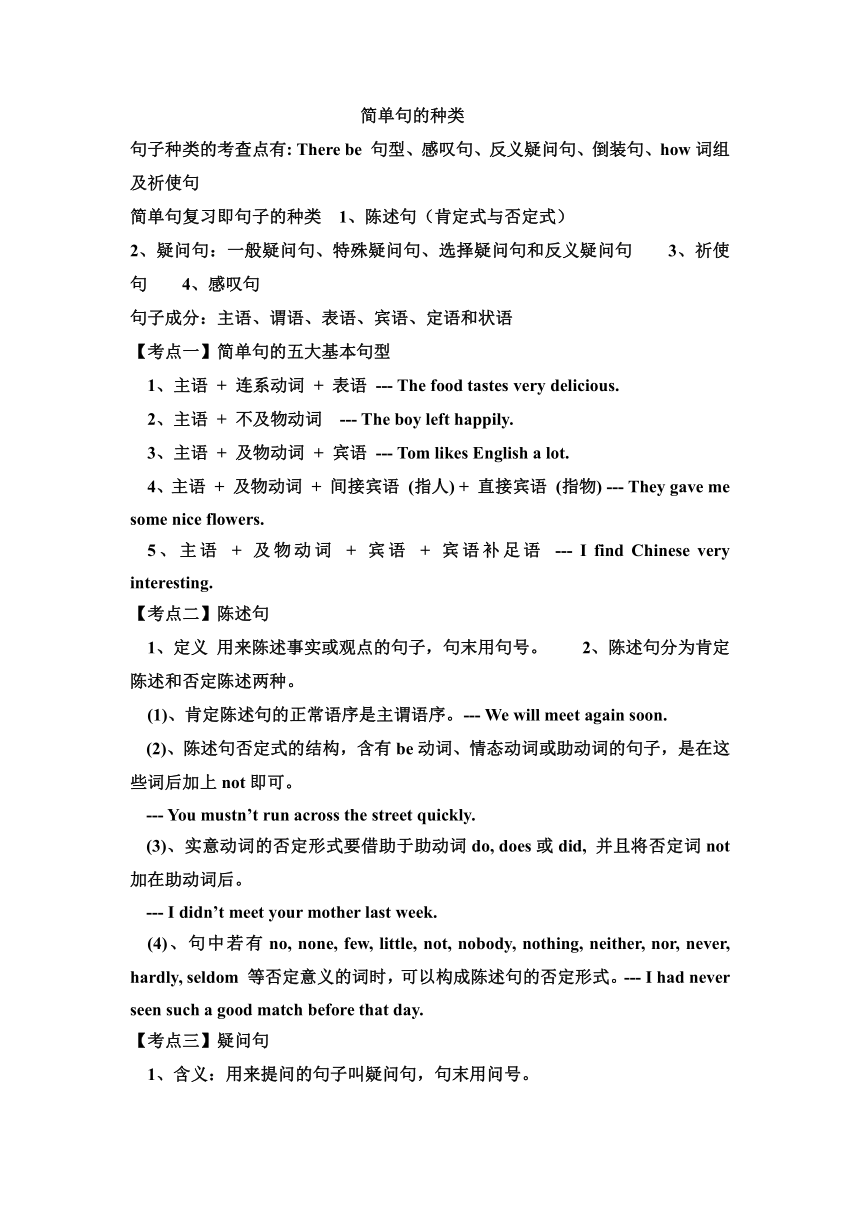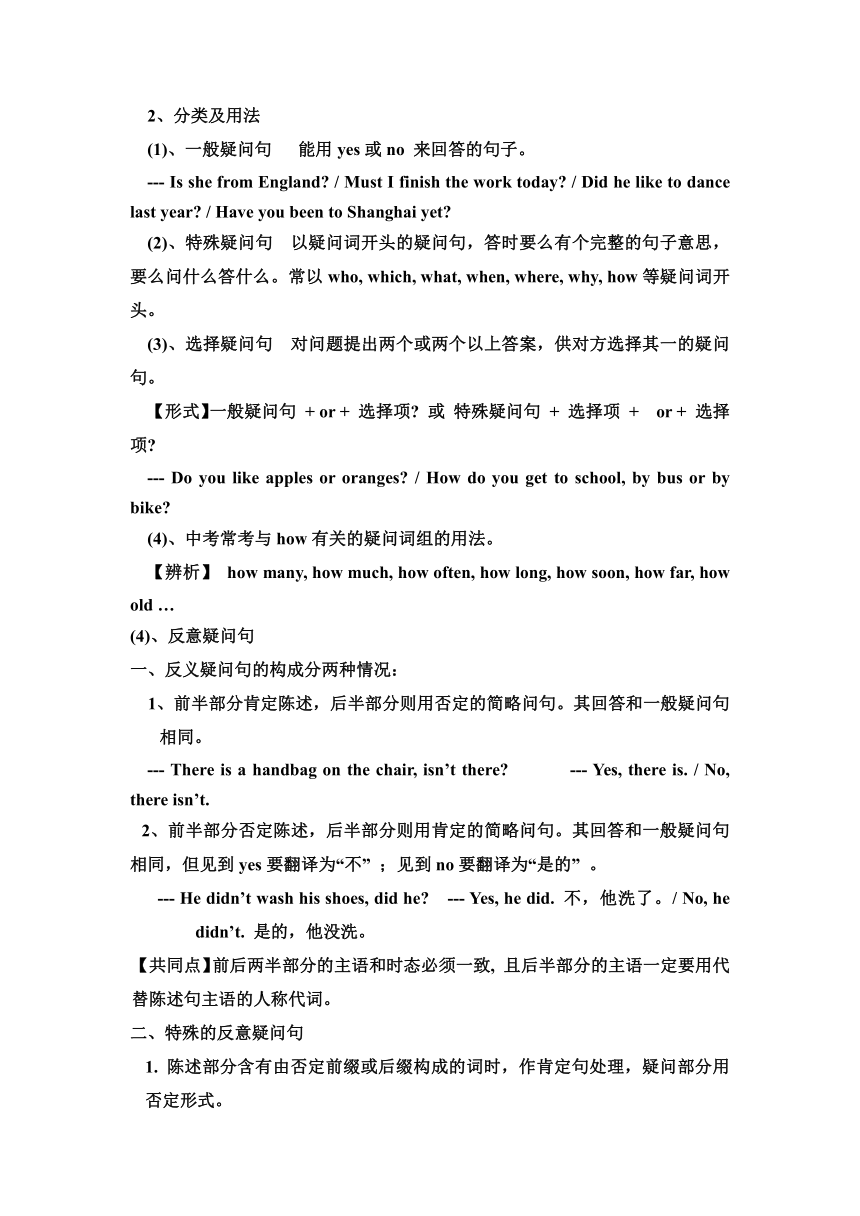2022年中考英语简单句的种类讲义(word版)
文档属性
| 名称 | 2022年中考英语简单句的种类讲义(word版) |  | |
| 格式 | docx | ||
| 文件大小 | 18.0KB | ||
| 资源类型 | 教案 | ||
| 版本资源 | 通用版 | ||
| 科目 | 英语 | ||
| 更新时间 | 2022-01-19 11:30:59 | ||
图片预览


文档简介
简单句的种类
句子种类的考查点有: There be 句型、感叹句、反义疑问句、倒装句、how词组及祈使句
简单句复习即句子的种类 1、陈述句(肯定式与否定式)
2、疑问句:一般疑问句、特殊疑问句、选择疑问句和反义疑问句 3、祈使句 4、感叹句
句子成分:主语、谓语、表语、宾语、定语和状语
【考点一】简单句的五大基本句型
1、主语 + 连系动词 + 表语 --- The food tastes very delicious.
2、主语 + 不及物动词 --- The boy left happily.
3、主语 + 及物动词 + 宾语 --- Tom likes English a lot.
4、主语 + 及物动词 + 间接宾语 (指人) + 直接宾语 (指物) --- They gave me some nice flowers.
5、主语 + 及物动词 + 宾语 + 宾语补足语 --- I find Chinese very interesting.
【考点二】陈述句
1、定义 用来陈述事实或观点的句子,句末用句号。 2、陈述句分为肯定陈述和否定陈述两种。
(1)、肯定陈述句的正常语序是主谓语序。--- We will meet again soon.
(2)、陈述句否定式的结构,含有be动词、情态动词或助动词的句子,是在这些词后加上not即可。
--- You mustn’t run across the street quickly.
(3)、实意动词的否定形式要借助于助动词do, does或did, 并且将否定词not 加在助动词后。
--- I didn’t meet your mother last week.
(4)、句中若有no, none, few, little, not, nobody, nothing, neither, nor, never, hardly, seldom 等否定意义的词时,可以构成陈述句的否定形式。--- I had never seen such a good match before that day.
【考点三】疑问句
1、含义:用来提问的句子叫疑问句,句末用问号。
2、分类及用法
(1)、一般疑问句 能用yes或no 来回答的句子。
--- Is she from England / Must I finish the work today / Did he like to dance last year / Have you been to Shanghai yet
(2)、特殊疑问句 以疑问词开头的疑问句,答时要么有个完整的句子意思,要么问什么答什么。常以who, which, what, when, where, why, how等疑问词开头。
(3)、选择疑问句 对问题提出两个或两个以上答案,供对方选择其一的疑问句。
【形式】一般疑问句 + or + 选择项 或 特殊疑问句 + 选择项 + or + 选择项
--- Do you like apples or oranges / How do you get to school, by bus or by bike
(4)、中考常考与how有关的疑问词组的用法。
【辨析】 how many, how much, how often, how long, how soon, how far, how old …
(4)、反意疑问句
一、反义疑问句的构成分两种情况:
1、前半部分肯定陈述,后半部分则用否定的简略问句。其回答和一般疑问句相同。
--- There is a handbag on the chair, isn’t there --- Yes, there is. / No, there isn’t.
2、前半部分否定陈述,后半部分则用肯定的简略问句。其回答和一般疑问句相同,但见到yes要翻译为“不” ;见到no要翻译为“是的” 。
--- He didn’t wash his shoes, did he --- Yes, he did. 不,他洗了。/ No, he didn’t. 是的,他没洗。
【共同点】前后两半部分的主语和时态必须一致, 且后半部分的主语一定要用代替陈述句主语的人称代词。
二、特殊的反意疑问句
1. 陈述部分含有由否定前缀或后缀构成的词时,作肯定句处理,疑问部分用否定形式。
--- He is an unhappy businessman, isn’t he
2. 陈述部分有not, neither, none, nobody, nothing, never, hardly, seldom, few, nor, little, no, too…to, no one等表示否定意义的词或结构时,疑问部分用肯定形式。--- He could hardly believe it, could he
3. 陈述部分是There be句型时, 附加部分需要用… be there
--- There is a cup of tea on the table, isn’t there
4. 陈述部分的主语为动词不定式、动名词或从句时,附加疑问句用it做主语。
--- It’s right to tell the truth, isn’t it
5. 陈述部分主语为this 或that 时,附加部分的主语用it ;陈述部分主语为these或 those 时,附加部分的主语用they。--- That is a Japanese car, isn’t it
6. 主语是everyone, someone, anyone, no one 等指人的不定代词时,多用they指代。
--- Everyone is here, aren’t they
7. 主语是everything, something, anything, nothing时, 用it代。Something is wrong with my radio, isn’t it
8. 祈使句有两种情况: (1). Let’s祈使句的反义问句用shall we (2). Let us (不包括对方) 用, will you
(3). 以动词原形开头的祈使句,不管是肯定还是否定,都用will you
--- Let’s go and play games, shall we / Let us have a taste, will you / Don’t laugh at him, will you
【考点四】祈使句
定义:没有主语,动词原形开头的句子。
【祈使句的肯定形式】 1. Do型: 实意动原 + 其他 Give it to me, please!
2. Be 型: Be + 表语 + 其他 Be kind to the old people!
3. Let型: Let + 宾语 + 其他 Let Li Lei play with you.
【祈使句的否定形式】在动词原形前加don’t.
1. Do型在句首加don’t. 即:Don’t do sth. --- Don’t run across the street.
2. Be 型也在句首加don’t. 即:Don’t be +adj. --- Don’t be late again. 别再迟到了。
3. Let型分两种
(1). Don’t + let + 宾语+ 动原+其他 --- Don’t let the children swim here.
(2). Let’s not + 动原 + 其他 --- Let’s not watch TV. It’s boring.
4. No + n / v-ing. 如:No talking. 禁止讲话。/ No photos. 禁止拍照。/ No parking. 禁止停车。
5. 祈使句反意问句的构成
Let’s用shall we 而Let us 以及所有的祈使句用will you
eg: Let’s go home, shall we 2. Don’t talk quietly, will you 3. Let us fly a kite, will you
6. 用于交际当中 --- Don’t forget me, please. --- No, I won’t.
(2). --- Make your bedroom right now. --- Yes, I will.
7. 第一人称和第三人称的祈使句,用let sb do sth的句型构成,表达建议、请求等意思。
--- Let me try. --- Let him do it all by himself. 8. 祈使句 + or / and 的句子结构。
【考点五】感叹句 其结构分为4种
1. What a / an + adj. + 单数名词! eg: What a good student! --- What an old house!
2. What + adj. + 复数名词或不可数名词! eg: What moving stories! --- What delicious soup!
3. How + adj. + 主语 +系动词 / 联系动词! eg: How lovely the boy is ! --- How beautiful the park looks!
4. How + adv. + 主语 + 行为动词!--- How carefully he drives!
5. How + 句子! --- How time flies! 光阴似剑;时间如飞! / How he wished that Chang’e could come back.
感叹句的回答和一般疑问句相同。 eg: --- How interesting the story is ! --- Yes, it is.
【感叹句引导词的判断】(1)、有a, an开头的用what (2)、形容词直接跟名词的用what (3)、其余的用how
句子种类的考查点有: There be 句型、感叹句、反义疑问句、倒装句、how词组及祈使句
简单句复习即句子的种类 1、陈述句(肯定式与否定式)
2、疑问句:一般疑问句、特殊疑问句、选择疑问句和反义疑问句 3、祈使句 4、感叹句
句子成分:主语、谓语、表语、宾语、定语和状语
【考点一】简单句的五大基本句型
1、主语 + 连系动词 + 表语 --- The food tastes very delicious.
2、主语 + 不及物动词 --- The boy left happily.
3、主语 + 及物动词 + 宾语 --- Tom likes English a lot.
4、主语 + 及物动词 + 间接宾语 (指人) + 直接宾语 (指物) --- They gave me some nice flowers.
5、主语 + 及物动词 + 宾语 + 宾语补足语 --- I find Chinese very interesting.
【考点二】陈述句
1、定义 用来陈述事实或观点的句子,句末用句号。 2、陈述句分为肯定陈述和否定陈述两种。
(1)、肯定陈述句的正常语序是主谓语序。--- We will meet again soon.
(2)、陈述句否定式的结构,含有be动词、情态动词或助动词的句子,是在这些词后加上not即可。
--- You mustn’t run across the street quickly.
(3)、实意动词的否定形式要借助于助动词do, does或did, 并且将否定词not 加在助动词后。
--- I didn’t meet your mother last week.
(4)、句中若有no, none, few, little, not, nobody, nothing, neither, nor, never, hardly, seldom 等否定意义的词时,可以构成陈述句的否定形式。--- I had never seen such a good match before that day.
【考点三】疑问句
1、含义:用来提问的句子叫疑问句,句末用问号。
2、分类及用法
(1)、一般疑问句 能用yes或no 来回答的句子。
--- Is she from England / Must I finish the work today / Did he like to dance last year / Have you been to Shanghai yet
(2)、特殊疑问句 以疑问词开头的疑问句,答时要么有个完整的句子意思,要么问什么答什么。常以who, which, what, when, where, why, how等疑问词开头。
(3)、选择疑问句 对问题提出两个或两个以上答案,供对方选择其一的疑问句。
【形式】一般疑问句 + or + 选择项 或 特殊疑问句 + 选择项 + or + 选择项
--- Do you like apples or oranges / How do you get to school, by bus or by bike
(4)、中考常考与how有关的疑问词组的用法。
【辨析】 how many, how much, how often, how long, how soon, how far, how old …
(4)、反意疑问句
一、反义疑问句的构成分两种情况:
1、前半部分肯定陈述,后半部分则用否定的简略问句。其回答和一般疑问句相同。
--- There is a handbag on the chair, isn’t there --- Yes, there is. / No, there isn’t.
2、前半部分否定陈述,后半部分则用肯定的简略问句。其回答和一般疑问句相同,但见到yes要翻译为“不” ;见到no要翻译为“是的” 。
--- He didn’t wash his shoes, did he --- Yes, he did. 不,他洗了。/ No, he didn’t. 是的,他没洗。
【共同点】前后两半部分的主语和时态必须一致, 且后半部分的主语一定要用代替陈述句主语的人称代词。
二、特殊的反意疑问句
1. 陈述部分含有由否定前缀或后缀构成的词时,作肯定句处理,疑问部分用否定形式。
--- He is an unhappy businessman, isn’t he
2. 陈述部分有not, neither, none, nobody, nothing, never, hardly, seldom, few, nor, little, no, too…to, no one等表示否定意义的词或结构时,疑问部分用肯定形式。--- He could hardly believe it, could he
3. 陈述部分是There be句型时, 附加部分需要用… be there
--- There is a cup of tea on the table, isn’t there
4. 陈述部分的主语为动词不定式、动名词或从句时,附加疑问句用it做主语。
--- It’s right to tell the truth, isn’t it
5. 陈述部分主语为this 或that 时,附加部分的主语用it ;陈述部分主语为these或 those 时,附加部分的主语用they。--- That is a Japanese car, isn’t it
6. 主语是everyone, someone, anyone, no one 等指人的不定代词时,多用they指代。
--- Everyone is here, aren’t they
7. 主语是everything, something, anything, nothing时, 用it代。Something is wrong with my radio, isn’t it
8. 祈使句有两种情况: (1). Let’s祈使句的反义问句用shall we (2). Let us (不包括对方) 用, will you
(3). 以动词原形开头的祈使句,不管是肯定还是否定,都用will you
--- Let’s go and play games, shall we / Let us have a taste, will you / Don’t laugh at him, will you
【考点四】祈使句
定义:没有主语,动词原形开头的句子。
【祈使句的肯定形式】 1. Do型: 实意动原 + 其他 Give it to me, please!
2. Be 型: Be + 表语 + 其他 Be kind to the old people!
3. Let型: Let + 宾语 + 其他 Let Li Lei play with you.
【祈使句的否定形式】在动词原形前加don’t.
1. Do型在句首加don’t. 即:Don’t do sth. --- Don’t run across the street.
2. Be 型也在句首加don’t. 即:Don’t be +adj. --- Don’t be late again. 别再迟到了。
3. Let型分两种
(1). Don’t + let + 宾语+ 动原+其他 --- Don’t let the children swim here.
(2). Let’s not + 动原 + 其他 --- Let’s not watch TV. It’s boring.
4. No + n / v-ing. 如:No talking. 禁止讲话。/ No photos. 禁止拍照。/ No parking. 禁止停车。
5. 祈使句反意问句的构成
Let’s用shall we 而Let us 以及所有的祈使句用will you
eg: Let’s go home, shall we 2. Don’t talk quietly, will you 3. Let us fly a kite, will you
6. 用于交际当中 --- Don’t forget me, please. --- No, I won’t.
(2). --- Make your bedroom right now. --- Yes, I will.
7. 第一人称和第三人称的祈使句,用let sb do sth的句型构成,表达建议、请求等意思。
--- Let me try. --- Let him do it all by himself. 8. 祈使句 + or / and 的句子结构。
【考点五】感叹句 其结构分为4种
1. What a / an + adj. + 单数名词! eg: What a good student! --- What an old house!
2. What + adj. + 复数名词或不可数名词! eg: What moving stories! --- What delicious soup!
3. How + adj. + 主语 +系动词 / 联系动词! eg: How lovely the boy is ! --- How beautiful the park looks!
4. How + adv. + 主语 + 行为动词!--- How carefully he drives!
5. How + 句子! --- How time flies! 光阴似剑;时间如飞! / How he wished that Chang’e could come back.
感叹句的回答和一般疑问句相同。 eg: --- How interesting the story is ! --- Yes, it is.
【感叹句引导词的判断】(1)、有a, an开头的用what (2)、形容词直接跟名词的用what (3)、其余的用how
同课章节目录
- 词法
- 名词
- 动词和动词短语
- 动词语态
- 动词时态
- 助动词和情态动词
- 非谓语动词
- 冠词
- 代词
- 数词和量词
- 形容词副词及其比较等级
- 介词和介词短语
- 连词和感叹词
- 构词法
- 相似、相近词比较
- 句法
- 陈述句
- 一般疑问句和否定疑问句
- 特殊疑问句及选择疑问句
- 反意疑问句
- 存在句(There be句型)
- 宾语从句
- 定语从句
- 状语从句
- 主谓一致问题
- 简单句
- 并列句
- 复合句
- 主谓一致
- 主、表语从句
- 名词性从句
- 直接引语和间接引语
- 虚拟语气
- 感叹句
- 强调句
- 倒装句
- 祈使句
- 句子的成分
- 句子的分类
- 题型专区
- 单项选择部分
- 易错题
- 完形填空
- 阅读理解
- 词汇练习
- 听说训练
- 句型转换
- 补全对话
- 短文改错
- 翻译
- 书面表达
- 任务型阅读
- 语法填空
- 其他资料
